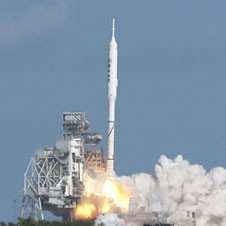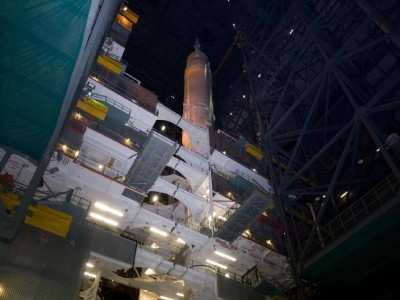Successful Test Ushers In A New Era Of Launch Vehicles
ANN Realtime Update 1255 EDT 10.28.2009:
 NASA's Ares I-X test rocket lifted off at 1130 EDT
Wednesday from NASA's Kennedy Space Center in Florida for a
two-minute powered flight. The test flight lasted about six minutes
from its launch from the newly-modified Launch Complex 39B until
splash down of the rocket's booster stage nearly 150 miles down
range.
NASA's Ares I-X test rocket lifted off at 1130 EDT
Wednesday from NASA's Kennedy Space Center in Florida for a
two-minute powered flight. The test flight lasted about six minutes
from its launch from the newly-modified Launch Complex 39B until
splash down of the rocket's booster stage nearly 150 miles down
range.
"This is a huge step forward for NASA's exploration goals," said
Doug Cooke, associate administrator for the Exploration Systems
Mission Directorate at NASA Headquarters in Washington. "Ares I-X
provides NASA with an enormous amount of data that will be used to
improve the design and safety of the next generation of American
spaceflight vehicles -- vehicles that could again take humans
beyond low Earth orbit."
The 327-foot tall Ares I-X test vehicle produced 2.6 million
pounds of thrust to accelerate the rocket to nearly 3 g's and Mach
4.76, just shy of hypersonic speed. It capped its easterly flight
at a sub-orbital altitude of 150,000 feet after the separation of
its first stage, a four-segment solid rocket booster.
Parachutes deployed for recovery of the booster and the solid
rocket motor will be recovered at sea for later inspection. The
simulated upper stage, Orion crew module, and launch abort system
will not be recovered.
"The most valuable learning is through experience and
observation," said Bob Ess, Ares I-X mission manager. "Tests such
as this -- from paper to flight -- are vital in gaining a deeper
understanding of the vehicle, from design to development."
Wednesday's flight offered an early opportunity to test and
prove hardware, facilities, and ground operations - important data
for future space vehicles. During the flight, a range of
performance data was relayed to the ground and also stored in the
onboard flight data recorder. The 700 sensors mounted on the
vehicle provide flight test engineering data to correlate with
computer models and analysis. The rocket's sensors gathered
information in several areas, including assembly and launch
operations, separation of the vehicle's first and second stages,
controllability and aerodynamics, the re-entry and recovery of the
first stage and new vehicle design techniques.

Photo Credit NASA TV
The Ares I-X efforts are led by the Ares I-X mission management
office of the Constellation Program, based at NASA's Johnson Space
Center in Houston, and NASA's Exploration Systems Mission
Directorate in Washington. NASA's Glenn Research Center in
Cleveland designed and built the vehicle's upper stage mass
simulator. NASA's Langley Research Center in Hampton, Va., provided
aerodynamic characterization, flight test vehicle integration and
the crew module/launch abort system mass simulator. NASA's Marshall
Space Flight Center in Huntsville, Ala., with contractor support,
provided management for the development of Ares I-X avionics, roll
control, and first stage systems. The Kennedy Space Center provided
operations and associated ground activities and launch
operations.
Contractors for Ares I-X include Alliant Techsystems, or ATK, of
Salt Lake City for the first stage solid rocket booster and
Teledyne Brown Engineering of Huntsville for the roll control
system. Jacobs Engineering of Tullahoma, Tenn., supported by
Lockheed Martin of Denver, provided the avionics systems. United
Space Alliance of Houston and ATK Launch Systems support the ground
systems and launch operations.
Original Story: In what appeared to be a
flawless launch, the 327-foot Ares 1-X rocket thundered away from
the launch pad at 1130 EDT Wednesday, marking the first time a new
vehicle has launched from the complex since the first space shuttle
launch in 1981.

The mission lated just two minutes, during which constant data
was received from the rocket.
At about the T+2 minute point in the flight, the upper stage
simulator and first stage separated at approximately 130,000 feet
over the Atlantic Ocean. The unpowered simulator splashed down in
the ocean. The first stage completed a controlled ocean landing
with parachutes, allowing recovery by one of NASA's booster
recovery ships, while the other ship tracks the upper stage.
According to NASA's Ares 1-X Launch blog, Kennedy Space Center
Director Bob Cabana congratulated the launch team and everyone
involved in today's success. "I'm just so proud of each and every
one of you," he said. "Outstanding job."
 ANN's Daily Aero-Linx (04.13.24)
ANN's Daily Aero-Linx (04.13.24) ANN's Daily Aero-Term (04.13.24): Beyond Visual Line Of Sight (BVLOS)
ANN's Daily Aero-Term (04.13.24): Beyond Visual Line Of Sight (BVLOS) Airborne 04.09.24: SnF24!, Piper-DeltaHawk!, Fisher Update, Junkers
Airborne 04.09.24: SnF24!, Piper-DeltaHawk!, Fisher Update, Junkers Aero-News: Quote of the Day (04.14.24)
Aero-News: Quote of the Day (04.14.24) ANN's Daily Aero-Term (04.14.24): Maximum Authorized Altitude
ANN's Daily Aero-Term (04.14.24): Maximum Authorized Altitude





